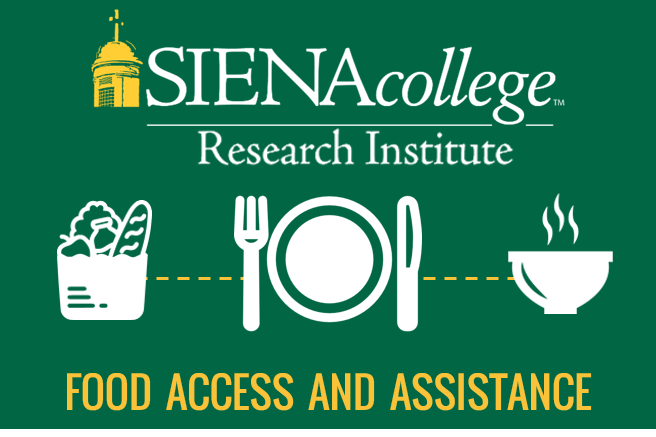- 86% of Capital District Residents Say Government Food Programs are Necessary; Just Over Half Say They are Being Misused
- Compared to Rest of State: More Capital District Residents Donate Food/Dollars for Hunger Relief; 2 in 10 Volunteer; Less Use SNAP or Food Pantries
- 8 in 10 Say Employment, Food Affordability, and Meal Planning are Significant Issues for Lower-Income Residents
- 94% Agree, “No One in New York Should Go Hungry,” on Par with Rest of State Rensselaer County Residents and Blacks/Hispanics Struggle Most to Put Food on Table
Loudonville, NY – Nearly 9 in 10 Capital District residents agree that “government food assistance programs are necessary programs that address a social need,” while a majority – 55% – agree that “in general, people on government food assistance programs misuse the system,” according to a new Siena College Research Institute poll conducted as part of a Community-Based Research course (COMD 210) at Siena. The study was conducted in partnership with The Food Pantries for the Capital District. Students in the course will present the survey’s full findings on Monday, April 24th at 6:30pm in the Standish Library on Siena’s campus.
Over the past 12 months, 59 percent of Capital District residents donated food to a food drive, bank, or pantry at least somewhat often, 10 points higher than New Yorkers overall (49%), and 53 percent made a monetary contribution to a charity focused on food or hunger, 8 points higher than statewide (45%). Twenty percent of Capital District residents and about the same number of New Yorkers (18%) volunteered their time at least somewhat often at a food pantry or drive in the past 12 months.
Yet, 9 percent of Capital District residents received government food assistance from programs like SNAP or WIC, and 5 percent received food from a food pantry or meals program at least somewhat often in the past 12 months, compared to 17 percent and 12 percent statewide.
“A majority of residents in the Capital District donate food and money for hunger relief at higher rates than New Yorkers overall, yet, statewide the number of people utilizing food pantries and government food assistance is about double that of the Capital District,” said Pete Cichetti, Co-instructor of COMD 210.
Large majorities of Capital District residents say that lower-income people in their area face at least somewhat, if not very, significant challenges across a range of issues. Food-related, 8 in 10 Capital District residents say that “being able to afford nutritious food” is at least a somewhat significant problem, on par with all New Yorkers (81%), while the same number say that “knowing how to plan healthy, nutritional meals” is a significant problem, slightly higher than residents statewide (74%). Overall, “being employed at a rate in which people can afford to live comfortably” was viewed as a somewhat or very significant problem for lower-income people by the most Capital District residents – at 82% – while “having quality education for young people” was viewed as a significant problem by the fewest Capital District residents, at 68 percent. Seventy-nine percent of Capital District residents say “having access to good, quality affordable housing” is a significant problem for lower-income residents, 78 percent “having access to affordable health care,” and 71 percent “having convenient access to nutritional, healthy food.” “Overall, 8 in 10 Capital District residents view food affordability and knowing how to plan healthy meals as significant problems for lower-income residents, almost as significant as jobs, and slightly more significant than affordable health care and housing,” said Cichetti.
Ninety-four percent of Capital District residents agree with the statement, “In New York State, no one should go hungry,” on par with New Yorkers overall (96%). A similar number – 90% – agree with the statement, “We should spend whatever it takes to make sure no one in New York State goes hungry.” Yet more than a third – 35% – agree with the statement “ I don’t think of hunger as a serious problem in this region.” In Albany County, 3 in 10 agreed with that statement, while in Saratoga County 44 percent agreed.
Nearly a third of black and Hispanic residents in the Capital District say that over the past 12 months they have “had a hard time affording to put food on the table for themselves or their families,” and “not eaten a full portion so others could have enough food,” compared to only 1 in 10 white residents. Similarly, 2 in 10 black/Hispanic residents took public transportation to get groceries while nearly the same number – 18% – used food stamps, SNAP, or WIC to purchase groceries in the last 12 months, significantly higher than white residents at 5% and 3% respectively.
At the county level, over the past 12 months Rensselaer County residents were most likely to use food stamps, SNAP, or WIC (14% at least somewhat often), skip a meal (15%), have a hard time putting food on the table (16%), not eat a full portion (23%), and purchase cheap food because it was all they could afford (24%).
“Across a number of indicators designed to measure how secure people are in being able to access and afford healthy food, black and Hispanic respondents, as well as Rensselaer County residents, jumped out as two of the least ‘food secure’ groups in the Capital District,” said April Backus, Associate Director of the Siena College Research Institute and Co-instructor of COMD 210.
“The data from this study helps us understand how local residents from different backgrounds living in different counties perceive a range of issues related to food access and affordability, which is invaluable for our coalition of 56 member food pantries in the Capital District as we work to improve food access and reduce hunger for all residents in the area,” said Natasha Pernicka, Executive Director of The Food Pantries for the Capital District.
The Siena students involved in creating and conducting the survey will present the full findings on Monday, April 24th from 6:30pm – 7:30pm in the Standish Library on the Siena College campus. The event is co-sponsored by The Food Pantries for the Capital District and is open to the public. For any additional questions concerning the event please contact April Backus at abackus@siena.edu or 518-782-6997.
For more information about The Food Pantries for the Capital District:
518-458-1167 or www.thefoodpantries.org
This Siena College Poll was conducted from March 16 to April 7, 2017 by telephone calls conducted in English to 600 residents in four counties in the Capital District – Albany County, Schenectady County, Saratoga County, and Rensselaer County. The margin of error for this survey is +/-4.0 percentage points, including the design effects resulting from weighting. Data was statistically adjusted by age, region, gender and race/ethnicity to ensure representativeness. The study was done as part of a Community-Based Research course at Siena taught by April Backus and Peter Cichetti. The 11 students in the course studied “food insecurity” and developed the survey instrument so as to assess the surrounding area for The Food Pantries for the Capital District. Sampling was conducted via a stratified multi-frame probability sample of both landline and cell phone telephone numbers from Survey Sampling International. All statewide numbers referenced above came from a previous SCRI survey conducted in March 2017 and released on April 4th. The Siena College Research Institute, directed by Donald Levy, Ph.D., conducts political, economic, social and cultural research primarily in NYS. SCRI, an independent, non-partisan research institute, subscribes to the American Association of Public Opinion Research Code of Professional Ethics and Practices. For survey crosstabs: scri.siena.edu.





